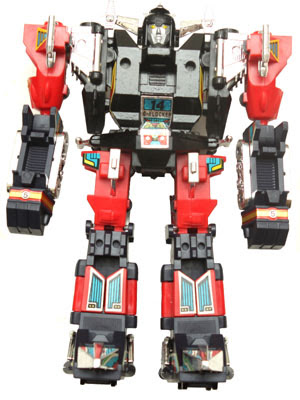A Diaclone Multi-Force 14 Robot toy from 1984.
Before this holiday season comes to an end, I thought that I would wrap up 2011 with a dose of holiday-themed geek nostalgia before we spring-launch into 2012. It's a flashback to another holiday season, when a particular trend that would impact all robot geeks for decades to come dominated toy store aisles across the country. This trend was the import and repackaging of Japanese robot toys, of which there were many. Read on for my eyewitness account of this amazing time, when Japanese robots of all shapes and sizes ruled Christmas wish lists.
The import of Japanese robot toys didn't start in the 80s and it certainly didn't end after the 80s were over, but I'll always remember 1984 as a major milestone for the stateside distribution of Japanese toy robots. By the time the Christmas shopping season of that year had rolled around, the Transformers and Gobots toy lines--toy lines of repackaged transforming robot toys from Japan--had already hit the shelves and proved to be a success, so retailers were gearing up to claim their piece of the Japanese robot pie.
While transforming robots were very popular at the time, they weren't the only Japanese robot toys that were arriving in the states in 1984. Revell had also released a series of robot model kits under the name "Robotech", which left many kids gawking for hours at these amazing, highly-detailed robot designs when they appeared in toy stores and hobby shops. (The anime series with the same title wouldn't debut in the U.S. until the following year.) The Japanese toy company Tomy had already released a few of its motorized Zoids robots and by 1984, it released more Zoids and the Starriors action figure line. But Tomy didn't stop there--it also released programmable, battery-powered robot toys of varying degrees of complexity, toys such as Omnibot, Omnibot 2000, and Verbot.
As if the transforming robots, model kit robots and programmable robots weren't enough, the fall of 1984 also saw the arrival of the Voltron toy series by Matchbox. The Voltron TV series and accompanying toy line was supposed to consist of episodes and toys from three different combiner robot anime series: Beast King GoLion, Armored Fleet Dairugger XV, and Lightspeed Electroid Albegas. While the Albegas series was eventually left out of the Voltron TV package and thus never aired in the U.S., Matchbox kept the Albegas robots in the Voltron toy line anyway. That decision left kids like me somewhat confused to see this third set of combining Voltron robots advertised and displayed alongside the two Voltron sets we recognized, but that didn't matter--it just meant that there were more robot toys for us to enjoy.
To clarify, the aforementioned toy and model lines--Transformers, Gobots, Robotech and Voltron--consisted of robots from different Japanese toy lines that were assembled and repackaged into U.S. toy lines. Some additional Japanese robots that were not picked up under the other lines were released under different, more Japanese-like toy line titles, such as Godaikin. While these other lines weren't as successful as their Americanized counterparts, the robot toys they provided were like nothing else offered in the U.S. at the time. Some of them were even available for mail order in the Sears, JCPenney and Montgomery Ward Christmas catalogs, which was a pretty impressive feat for imported toy lines that lacked name recognition.
From the Godaikin line: Abega, a three-robot combiner vehicle . . .
. . . and Gardian, a three-in-one robot combiner. Gardian currently has a recurring
cameo role as a detective's desk decoration on the Rizzoli and Isles TV show.
cameo role as a detective's desk decoration on the Rizzoli and Isles TV show.
All of these imports led up to the Christmas shopping season of 1984, when the trend hit its peak. I remember walking into a toy store at the beginning of this shopping season and beholding a huge display devoted to Matchbox's Voltron toy line (both complete sets and individual toys), which was flanked by other Japanese robot toys (some Americanized, some not). I fell into a state of Japanese robot nirvana when I saw this massive display--it was like witnessing the second coming of the Shogun Warrior line.
A display of Matchbox's entire Voltron toy line from 1984.
Sure, the Transformers line is as popular today as it was back then, Voltron still shows up every now and then, and plenty of Japanese robot toys and model kits are readily available now for purchase online and in toy stores and hobby shops. Nevertheless, I haven't seen anything like this 1984 toy store display before or since then--it's the stuff of which robot geek Christmas memories are made.



















